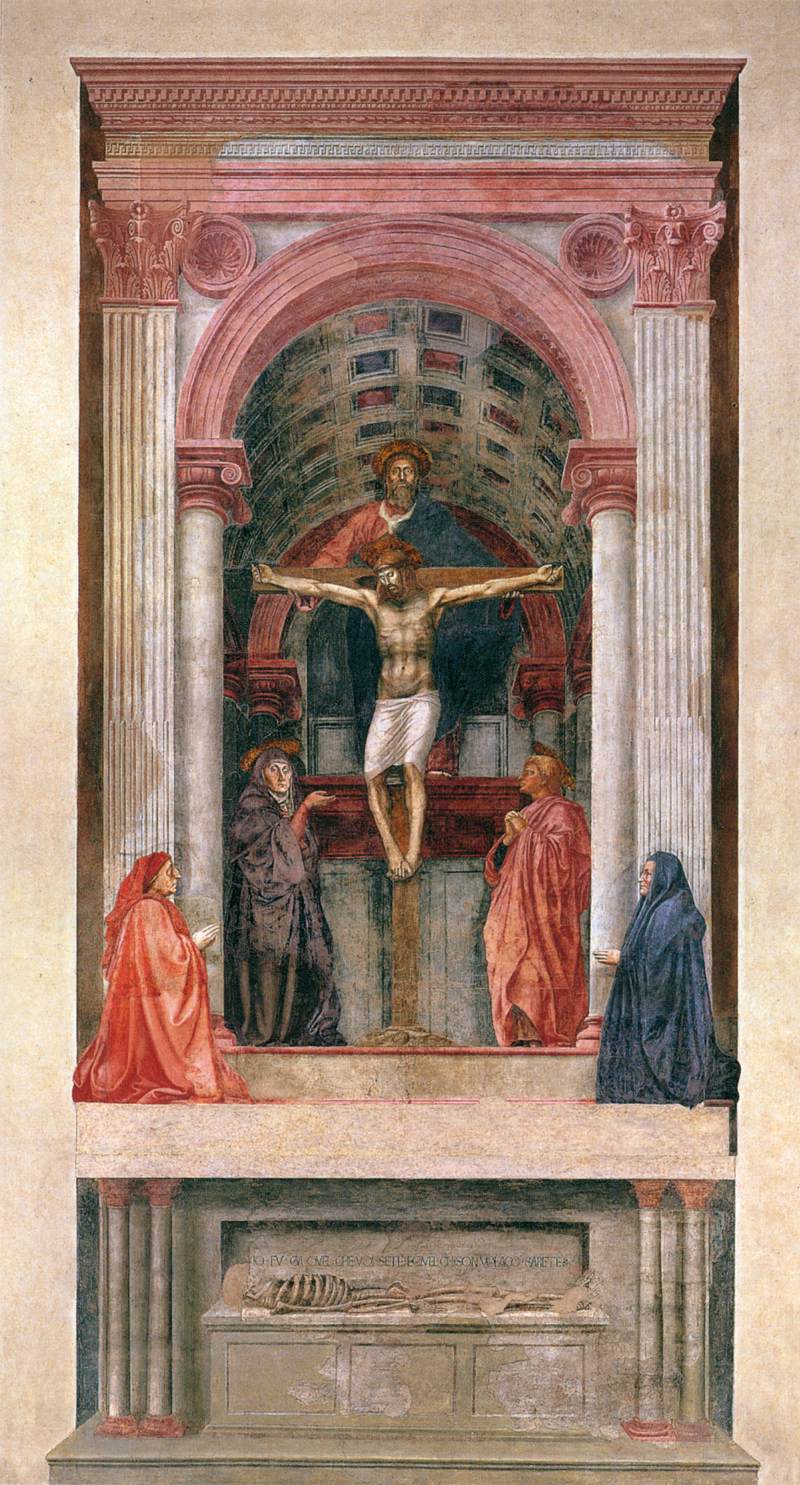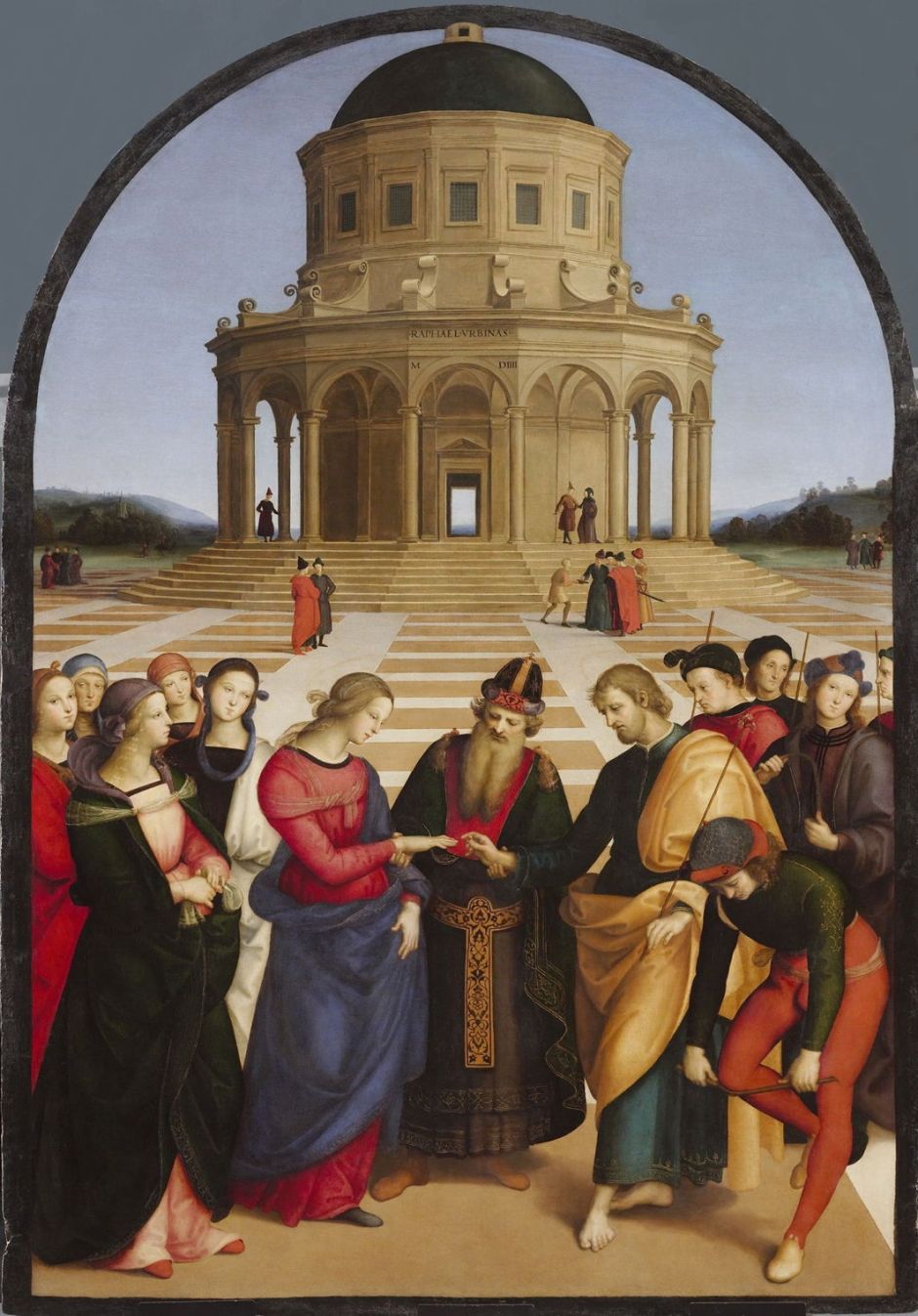If you were to name the single most visible change which the Renaissance brought to painting in Italy, for most it would be the introduction of geometrically correct linear perspective projection. In many paintings, the accuracy of their perspective demonstrates whether they were painted before 1425 or after. To most modern eyes, ‘errors’ in perspective projection appear glaring, and fine paintings made before 1425 seem ‘primitive’ because of their multiple vanishing points.
This change in perspective reflected a major underlying change in the intention of visual art: prior to the Renaissance, many paintings weren’t intended to be physically accurate two-dimensional representations of a three-dimensional reality, but arrangements of flat symbols, closer to writing than to realist painting. It was only when and where artists strived for realism that accurate perspective projection became so important.

Although the Romans loved the trompe l’oeil, no surviving work of visual art from Roman times comes close to demonstrating an understanding of modern perspective projection. We cannot know whether those who saw this fresco in the Villa of P. Fannius Synistor, in Boscoreale, Italy, would have recognised the incoherence of its perspective projection, though.
Before 265 BCE, Euclid established the geometrical and optical principles necessary to perform modern perspective projection, but amazingly neither he nor successors such as Hero or Ptolemy quite reached it. It also eluded the polymath Roger Bacon in the thirteenth century.

Painted just a century before the discovery of modern perspective projection, works like Duccio’s Healing of the Man Born Blind appear odd to modern eyes. Aside from its multiplex narrative, in which the blind man is shown standing next to himself, Duccio’s inability to project the lines of the buildings to coherent vanishing points now appears ‘primitive’ or amateur. At the time, just as in Roman urban views, it must have seemed more ‘natural’, though.

Of all the pre-Renaissance painters, it must have been Ambrogio Lorenzetti who came closest to realising the coherence of vanishing points which is key to unifying a projection from three to two dimensions. His fresco of the Effects of Good Government in the City (1338-39) in Siena comes closer than many.

Slightly later, his Presentation in the Temple (1342) comes even closer, and some have claimed that it was he who first achieved modern projection. His use of a geometric pattern in the floor may give the impression that it has been projected correctly, but this was a not uncommon ploy among those striving for realist effect. In fact, as I’ve shown below, his vanishing points remained multiple and incoherent.

Using one or two coherent vanishing points wasn’t the only possible solution either. Artists in eastern Asia had already discovered a solution which worked well for them.

The development of sophisticated and highly-detailed visual art in Asia arrived at what’s now known as the oblique projection. Whereas Roman and subsequent European visual art effectively had multiple and incoherent vanishing points, Asian art usually lacked any vanishing point, but aligned recession in parallel. An important factor here is the use of long scrolls, which even now make fully coherent perspective projection unsuitable.

Oblique projections still work well along the length of a scroll, as in any sectional view they are close to a modern coherent projection.
The discovery of linear perspective projection is attributed to the Florentine architect Filippo Brunelleschi (1377-1446) in about 1420, although it may have been as early as 1414. Antonio Manetti, his biographer, wrote an account in which Brunelleschi constructed two paintings of churches in Florence according to geometrical optical principles, and made an arrangement using a small hole and a mirror so that a viewer could compare the 2D painted view with the observed view at the correct locations. Those who tried this out were apparently amazed at the similarities between the 2D and observed views.
The effects on paintings can be seen in two frescoes which were completed just a few years apart.

Masolino painted his Healing of the Cripple and the Resurrection of Tabitha in the Brancacci Chapel in Florence between 1424-25, but wasn’t one of those who shared Brunelleschi’s secret method. Although it comes tantalisingly close to a correct projection, its incoherence is perceptible.

The first substantial painting (to have survived) which employed Brunelleschi’s system is Masaccio’s magnificent Holy Trinity, painted in 1426-28 in the Basilica of Santa Maria Novella in Florence.
Response to this, and other contemporary paintings which employed the projection, was telling. Despite the geometric challenges, and the lack of published methods, modern perspective projection spread rapidly and became very widely adopted throughout Europe. Within a few decades, representational drawing and painting was expected to conform to modern projection, it was exploited in wall and ceiling paintings in huge trompes l’oeil, and the most skilled artists took on challenges such as extreme foreshortening.
Most significantly, modern perspective projection arrived at a time of increasing urbanisation, when rectilinear objects were becoming increasingly important in representational art, and it is likely that earlier incoherent projections were looking increasingly incorrect.

By 1504, when Raphael painted The Marriage of the Virgin, known by its Italian name of Il Sposalizio (‘the marriage’), it wasn’t uncommon for artists to include a tour-de-force of perspective such as the building shown here. It announced that they too had mastered this new technique, and isn’t this realistic.
Was this an important contribution to realism, or was it just a novelty? Did pre-Renaissance minds see the difference?
In 1907, initial explorations of Cubism were being exhibited by Pablo Picasso and Georges Braque. For the first time in almost five hundred years, representational paintings were deliberately flaunting their violation of perspective projection. The result was perceptually strange, transient in popularity, and did nothing to replace modern perspective projection, which has remained central to representational art. With the wisdom of hindsight, it was a short-lived experiment which brought no lasting change.
Recent extensive scientific investigations of visual perception, painstakingly analysed by Wagner and others, have concluded that humans in the latter half of the twentieth century perceive the world in a projection which is close to – but not identical with – modern perspective projection. Whether that has always been the case remains open to speculation, and because of pervasive exposure to perspective projection can never be tested.
Perhaps the most important question, though, is how much perspective was an end in itself. The evidence from the century or so before Masaccio’s Holy Trinity suggests that it was just part of the quest for realism, for the creation of paintings which more closely resembled what we perceive of the world around us. As such, it was but a sign of the Renaissance rather than a requirement.
References
Andersen K (2007) The Geometry of an Art. The History of the Mathematical Theory of Perspective from Alberti to Monge, Springer. ISBN 978 0 387 25961 1.
Brener ME (2004) Vanishing Points. Three Dimensional Perspective in Art and History, MacFarland. ISBN 978 0 7864 1854 1.
Dunning WF (1991) Changing Images of Pictorial Space. A History of Spatial Illusion in Western Painting, Syracuse UP. ISBN 978 0 8156 2508 7.
Gombrich EH (1976) The Heritage of Apelles. Studies in the Art of the Renaissance, Phaidon Press, Oxford. ISBN 0 7148 1708 2.
Panofsky E, tr Wood CS (1997) Perspective as Symbolic Form, Zone Books. ISBN 978 0 9422 9953 3.

